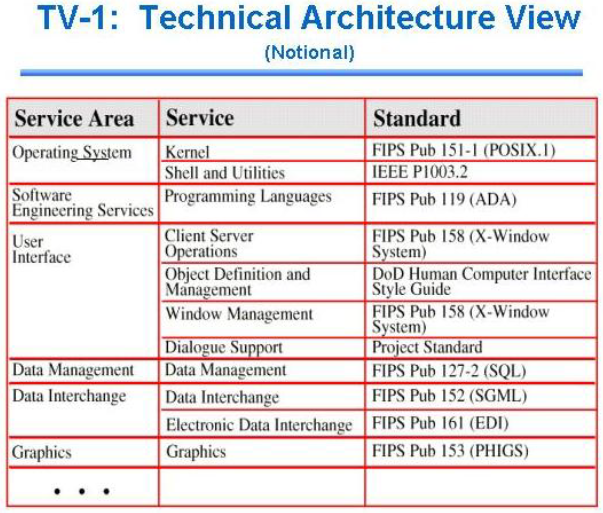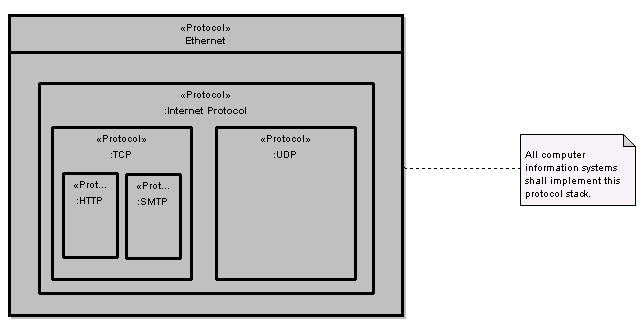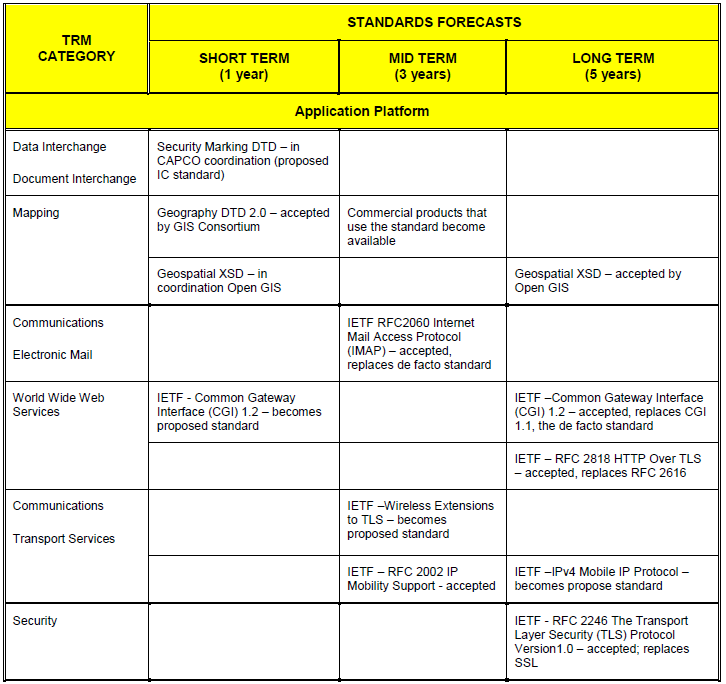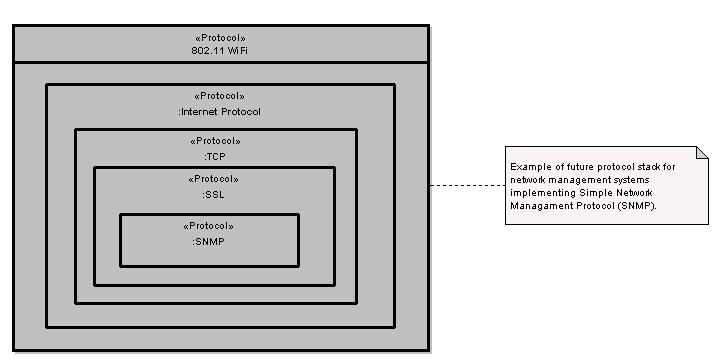Nato Architecture Framework (NAF) - 3.6 - NATO Technical View
Jump to navigation
Jump to search
<slideshow style="nobleprog" headingmark="。" incmark="…" scaled="false" font="Trebuchet MS" >
- title
- NAF - Part 3.6 - NATO Technical View
- author
- Bernard Szlachta (NobleProg Ltd)
</slideshow>
NTV, NATO Technical View
NTV-1, Technical Standards Profile。
- The Technical Standards Profile (NTV-1) provides a list of standards guiding and constraining the implementation of systems as defined in the various subviews of the NATO System View
- The NTV-1 standards, preferably, are NATO standards, as this will allow NATO to review the conformance of system implementation with the policy related to mandatory interoperability standards.
Running Example
NTV-1, Technical Standards Profile。
Definition
- The NTV-1 subview references the technical standards that apply to the architecture and how they need to be, or have been, implemented
- The technical standards govern what hardware and software may be implemented and on what system
- The standards that are cited may be:
- Public standards such as ISO and IEEE standards, but also public standards included in the NATO Interoperability Standards and Profiles (NISP);
- NATO standards, such as listed in the NISP
- Domain-specific NATO standards, such as standards specific to an aspect or function of the operational domain that is a subject of the architecture. E.g. specific Intel, Logistics or Security standards. These standards, often, are based on NATO-standards
- In the application of standards, domain-specific NATO standards should supersede the more general NATO-standards, which in turn supersede public standards
- Identified standards may require tailoring to fulfil the needs of the architecture; this tailoring is called creating a standards profile.
- Standards must maintain full compatibility with the root standards they have been derived from
- In addition, NTV-1 may state a particular method of implementation for a standard, as compliance with a standard does not ensure interoperability.
- The standards cited must reference the architecture elements that the standards impact upon.
NTV-1, Technical Standards Profile。
Development Guidance
- In most cases, developing an NTV-1 is best carried out by identifying the applicable portions of existing technical guidance and policy documentation, and then tailoring those portions as needed, in accordance with the latitude allowed, and filling in any gaps
- For NATO architectures, at least, this approach implies identifying the applicable portions of the NISP, selecting standards from the NISP, tailoring them as needed and filling in any gaps.
Running Example
Nato_Architecture_Framework_(NAF)_-_4.7_-_NATO_Meta_Model_-_NTV#NTV-1_Technical_Standards_Profile
NTV-2, Technical Standards Forecast。
- The purpose of the Technical Standards Forecast subview (NTV-2) is to identify emerging, obsolete and fragile standards, and to assess their impact on the architecture and its constituent elements
- A forecast addressing emerging standards will give insight into the direction that the project will go.
NTV-2, Technical Standards Forecast。
Example
NTV-2, Technical Standards Forecast。
- Definition
- The NTV-2 forecast describes expected changes in technology related standards and conventions, which are documented in the NTV-1 product
- The forecast relates these changes in standards to the time periods mentioned in the NSV-8 and NSV-9 subviews
- For example, a system's evolution description, specified in NSV-8, may be tied to a future standard identified in NTV-2, and a timed technology forecast from NSV-9 may be dependent on the adoption of an emerging standard, forecasted in NTV-2
- In short, the future change of systems may depend on, or be driven by the nature and acceptance of future standards
- The forecast should include the following:
- predictions for (change in) market acceptance of standards, both existing NTV-1 standards, emerging standards, and fading standards
- an overall risk assessment associated with using changing standards, especially with using emerging standards, or maintaining standards that are in danger of becoming obsolete
- issues and recommendations, based on an analysis of the potential impact of changing standards on the current architecture
NTV-2, Technical Standards Forecast。
Development Guidance
- The forecast is time phased to facilitate a structured, disciplined process of system development and evolution
- Time phasing also promotes the consideration of emerging technologies and likelihood of current technologies, standards, templates and templates becoming obsolete
- The length of the timed phases should be determined by the stakeholder, in conjunction with the architect, and should be commensurate with the purpose of the architecture
- As an example: the forecast horizon may be placed at 2 years, 6 years or 12 years, coinciding with the suggested life-cycle duration of, respectively, short-term, medium-term and long-term architectures.
NTV-2, Technical Standards Forecast。
Running Example
Nato_Architecture_Framework_(NAF)_-_4.7_-_NATO_Meta_Model_-_NTV#NTV-2_Technical_Standards_Forecast
NTV-3, Standard Configurations。
- Describe standard configurations that are applied to or emerge from the architecture effort, used or encountered in any of the subviews developed in the architecture effort.
- Is intended to capture and explicitly describe configurations that are of value to the ongoing or to future architecture projects
- It is also the intention of this subview to provide a single point to address and promote the use of standard configurations.
Definition
- The application of standard configurations shortens the architecture effort and provides for a better design by reusing readily available and already proven designs
- The use of standard configurations is mandatory in NATO projects that involve software intensive systems, because it is intended to improve interoperability, which is one of the key requirements for NATO systems
- New and improved configurations are recorded to help guide future architecture projects that may have to cope with similar issues or problems.
- The architectures themselves must explicitly mention and describe standard configurations, or else they will not be recognized as such, and consequently, will not be available for future projects or recognized by future architects.
NTV-3, Standard Configurations。
Development Guidance
- Standard configurations are best described using the same techniques as the ones used in the subviews where the configuration is applied or identified. E.g. a standard configuration of systems is probably best described using the method of description used in NSV-1
- Because for their potential of improving interoperability, mitigating design risk and speeding up the design process, standard configurations should be reused where and whenever possible
- The use of standard configurations may even be mandatory
- When standard configurations are used, this should be recorded by explicitly referencing the source
Exercises
- From NMM find out how to depict standard configuration in the UML diagram
- Copy and modify one of NSV-1 diagrams to make them NTV-3 compliant
Nato_Architecture_Framework_(NAF)_-_4.7_-_NATO_Meta_Model_-_NTV#NTV-3_Standards_configuration




